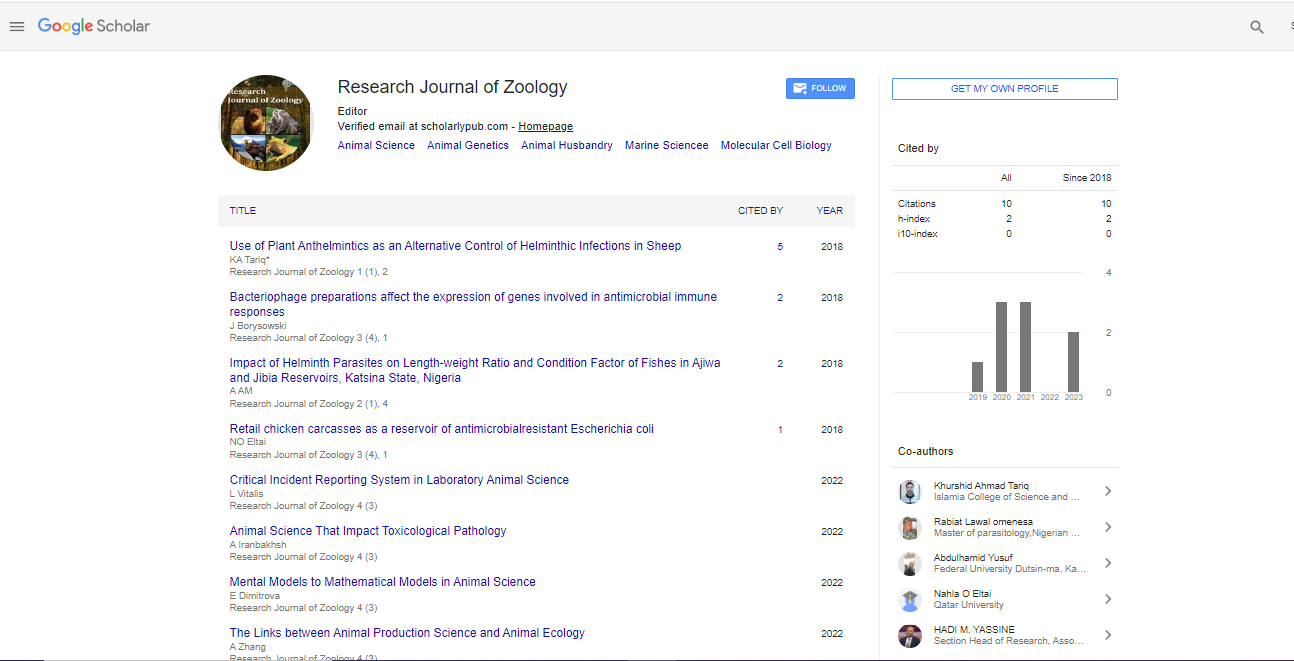Commentary, Res J Zool Vol: 5 Issue: 4
Structure and Function of Animal Physiology and its Classification
Sayed Zan*
1Department of Animal Science and Technology, Northwest A&F University, Shaanxi, China
*Corresponding Author: Sayed Zan,
Department of Animal Science
andTechnology, Northwest A&F University, Shaanxi, China
E-mail: zan.say@gmail.com
Received date: 21 November, 2023, Manuscript No. RJZ-24-128424;
Editor assigned date: 23 November, 2023, PreQC No. RJZ-24-128424 (PQ);
Reviewed date: 07 December, 2023, QC No. RJZ-24-128424;
Revised date: 15 December, 2023, Manuscript No. RJZ-24-128424 (R);
Published date: 22 December, 2023, DOI: 10.4172/RJZ.1000100.
Citation: Zan S (2023) Structure and Function of Animal Physiology and its Classification. Res J Zool 5:4.
Description
Animal physiology is a captivating field of study that examines into the complicated mechanisms controlling the functioning of diverse organisms. From the microscopic intricacies of cellular metabolism to the macroscopic coordination of organ systems, animal physiology encompasses a wide range of phenomena.
Cellular physiology
The foundation of animal physiology is found the cellular level, where a number of biochemical reactions orchestrate the stability of living organisms. From the production of Adenosine Triphosphate (ATP) through cellular respiration to the intricate signaling pathways regulating gene expression, cells serve as the fundamental elements of life. The principles of membrane transport, enzymatic reactions, and energy metabolism elucidate the dynamic equilibrium essential for cellular homeostasis.
Neurophysiology
The nervous system is an evolutionary adaptation, enabling animals to perceive, process, and respond to stimulate in their environment. Neurophysiology elucidates the intricate workings of neurons, synapses, and neural circuits, investigating the mechanics associated with emotion, perception, and motor control. From the Arcs of reflexes that ensure immediate response to complex cognitive processes, the nervous system embodies the essence of animal physiology's integrative nature.
Cardiovascular physiology
The cardiovascular system serves as the lifeline of animals, facilitating the transport of nutrients, gases, and waste products throughout the body. The intricacies of cardiac physiology, including heart rate regulation, cardiac output modulation, and vascular dynamics, dictate the organism's metabolic demands and environmental adaptations. From The aesthetic efficiency of bird hearts to the endurance of mammalian circulation, cardiovascular physiology demonstrates nature's multiple solutions to the difficult task of maintaining life.
Respiratory physiology
Respiration is fundamental to animal existence, providing the oxygen necessary for cellular metabolism while eliminating carbon dioxide waste. Respiratory physiology elucidates the mechanisms of gas exchange, ventilation, and oxygen transport, highlighting the adaptations of different organisms to diverse environmental conditions. From the effective veins of fish to the intricate lungs of mammals, respiratory physiology represents the evolutionary developed intelligence through millions of years of evolution by natural selection.
Digestive physiology
The digestive system serves as the energy acquisition, nutrient absorption, and waste disposal in animals. Digestive physiology discovers the procedures of ingestion, digestion, absorption, and excretion, elucidating the intricacies of nutrient processing and energy metabolism. From the specialized adaptations of herbivorous animals to the efficiency of carnivorous digestion, the digestive system exemplifies nature's optimization of nutrient utilization across ecological sectors.
Endocrine physiology
The endocrine system orchestrates a symphony of hormonal signals that regulate different physiological processes, from metabolism and growth to reproduction and behavior. Endocrine physiology introduces the complex feedback mechanisms and hormonal cascades controlling homeostasis and adaptation in animals. From the pulsatile release of hypothalamic hormones to the target organ responses mediated by the endocrine system, the endocrine system epitomizes the integrative control mechanisms essential for animal survival.
Reproductive physiology
Reproduction is central to the perpetuation of life, affecting the development of various reproductive techniques across the animal kingdom. Reproductive physiology elucidates the hormonal, anatomical, and behavioral mechanisms controlling the generation of gametes, fertilization, pregnancy, and parenting. From the complicated attracting practices of birds to the complex hormonal cycles of mammals, reproductive physiology demonstrates the diversity of life techniques created by evolutionary factors.
 Spanish
Spanish  Chinese
Chinese  Russian
Russian  German
German  French
French  Japanese
Japanese  Portuguese
Portuguese  Hindi
Hindi 
